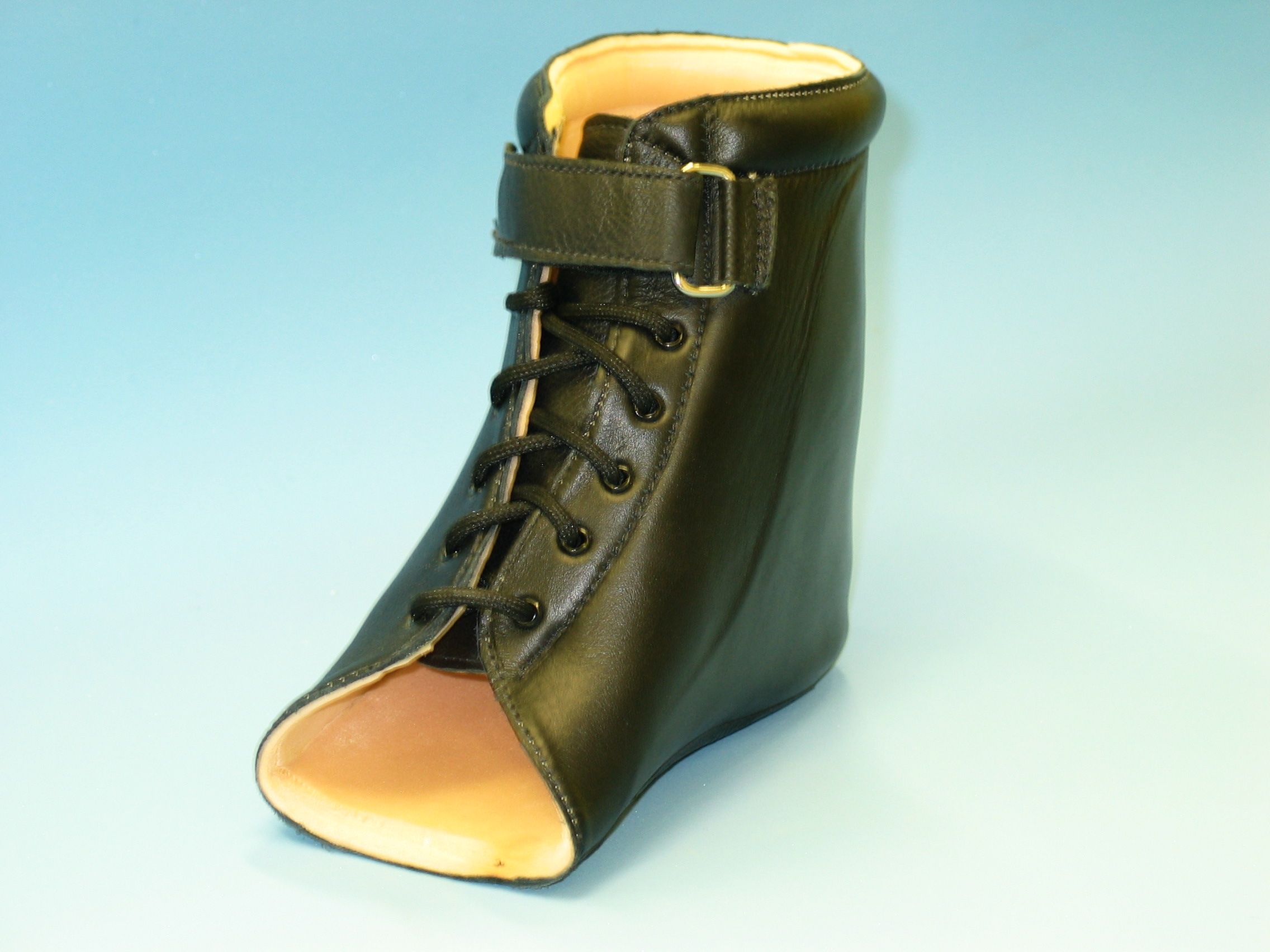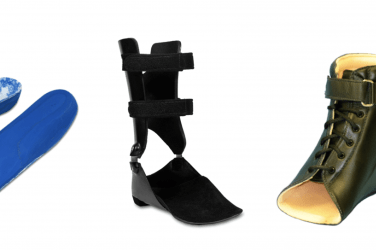Over the last decade or so, several new orthoses have been introduced to the O&P market that could be considered hybrids between an AFO and a custom foot orthotic. One such device incorporates hinged double-upright supports with a custom foot orthotic. The foot orthotic is manufactured using traditional methods and typically includes a good medial flange for mid-foot control. Stirrup-like clips, with pivot points at the ankle-joint axis, are also part of the orthotic. The non-custom uprights are selected based on considerations such as patient weight and size and then riveted to the medial and lateral clips. The brace serves a niche market and can be effective for posterior tibial tendon dysfunction (PTTD) and ankle instability, among other diagnoses.
The success of the device rests on the fact that it gives more support than a conventional custom foot orthotic – even a UCBL or SMO – but it is not as bulky as a traditional full AFO. It fills a role in between the two.
The Plastic-in-Leather Ankle Gauntlet
Another device that has re-emerged in the hybrid space is the ankle gauntlet, also known as the leather lacer. The relatively recent use of a plastic shell as the supportive base for these gauntlets makes them an attractive choice when ankle stability is a main concern.
Traditionally, gauntlets were made using 6 oz.+/- (4.5 Iron) molding leather. A full circumferential plaster cast of the lower leg, ankle, and foot was taken, and a positive was poured. This was then modified to correct the dysfunction, and varus or valgus deviations of the heel and forefoot were balanced intrinsically. Lining leather was added over the positive. Molding leather was then soaked and secured to the cast using some combination of nails, staples, or straps. After forming the shape-which often took several days-the stiff leather shell was removed. An optional layer of outer leather was sometimes added, and two rows of lace eyelets were installed along the length of the opening.
Leather gauntlets were bulky and took time to make, but they did provide good control for the ankle area. Due to the time-consuming nature of the fabrication work involved, their popularity declined in favor of the “newer” types of AFOs. Thermoplastic AFOs had several advantages over leather gauntlets:
1. They took less time to fabricate. Plastic cools faster than leather dries.
2. They offered more support for the foot and ankle, and they could be enhanced for a much wider range of diagnoses, such as foot drop or weak quadriceps function.
3. They required less time from the highly skilled technicians who had to work with the leather.
4. They could be adjusted more easily and accurately by simply using a heat gun.
Despite the clear advantages of AFOs, ankle gauntlets still have their place in every practitioners toolbox. Foot orthotics have proven to be excellent for controlling improper motion of the subtalar joint (STJ) and other foot-specific pathologies. Full AFOs can be designed to provide support and partial or full control in all three planes of the lower extremity. They can also aid in flexion assistance. However, some patients need a little more control than that offered with a custom foot orthotic, but they do not require or will not tolerate wearing a full AFO, due to either its bulk or lack of cosmesis. In addition, recent thinking regarding orthotics suggests that, generally speaking, it is better to restrict patients less and allow beneficial motion to occur. This approach also enhances proprioception, an essential component of neuromuscular control and balance.
All orthotics should aid control without unnecessarily limiting motion, thus preventing muscle atrophy and joint pain. The introduction of a flexible or semi-rigid poly shell into a gauntlet-style device was an innovative response to an emerging patient need. Replacing the molding leather with a thin thermoplastic took the advantages of an AFO and combined them with the extra stability of a closure system-while not fully restricting motion or taking up too much room in the shoe.
Indications for Use

As with all modalities, the practitioner will have to use his or her experience and judgment to determine when an ankle gauntlet is the most appropriate orthosis for the patient. Originally developed as a treatment for non-operative management of PTTD, the effectiveness of the plastic-in-leather gauntlet was studied in relation to patients suffering from Stages I and II of the disease. At the outset, these patients will usually have pain, tenderness, and swelling along the PT tendon, with some loss of function. They will often present with a flat foot, edema, and a medial bulge of the talonavicular joint on the affected side. (Authors note: For a fuller discussion of PTTD, visit https://hersco.com/education-center/posterior-tibial-tendon-dysfunction/)
Further indications include chronic ankle instability, talocalcaneal varus or valgus, severe pes planus, ankle arthritis, tarsal tunnel syndrome, and non-operative management of certain cases of Charcot breakdown and degenerative joint disease (DJD) of the hindfoot and ankle. The benefits of gauntlets lie in the full support they offer the ankle complex while still being relatively easy to apply, and their minimal interference to ambulation.
Patient-specific considerations will determine the choice of closure-either laces, Velcro, or a combination of both. Laces tend to be more secure, but patients who have difficulty with activities of daily living (ADL) may find Velcro easier to don. Gauntlets can be constructed with a cut-out heel, which is often a good option to ensure an easier shoe fit. Cut-out heels also allow some beneficial range-of-motion of the calcaneous/STJ. Leather linings are the thinnest and most durable, but Plastazote is a better choice for patients with pain or sensitivity. Pads also can be incorporated beneath the lining of the brace to provide extra support or cushioning when necessary.
If the primary goals of orthotic intervention is to create stability and allow functional mobility, while not requiring excessive energy, then the ankle gauntlet has an important place in the practitioners spectrum of choices. Obviously, gauntlets should not be used beyond their range of effectiveness, and patients who need a true AFO should get one. Ankle gauntlets are certainly not a panacea for all foot and ankle pathologies, but they are a very effective and useful option.
Séamus Kennedy, BEng (Mech), CPed, is president and co-owner of Hersco Ortho Labs, New York. He can be contacted via e-mail at seamus@hersco.com or by visiting www.hersco.com.















